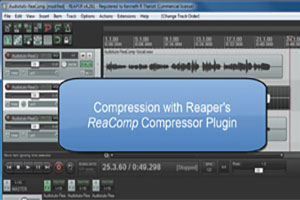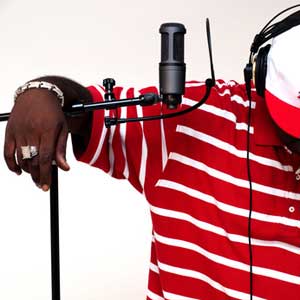 I just had my first audio recording tutorial video published by AudioTuts+. The video shows you how to compress a vocal track using the compressor plugin effect, ReaComp, that comes with Reaper audio recording software. If you’d like a refresher on what the compression effect is for, see our article: What Does Compression Mean In Audio Recording?
I just had my first audio recording tutorial video published by AudioTuts+. The video shows you how to compress a vocal track using the compressor plugin effect, ReaComp, that comes with Reaper audio recording software. If you’d like a refresher on what the compression effect is for, see our article: What Does Compression Mean In Audio Recording?
In this video, I show you how to place ReaComp on a vocal track in Reaper (my dulcet tones doing a bit of singing). Then I walk you through the settings screen and explain the main controls and meters so you can see how the voice is affected by them. Then I show you how to set the starting levels for the threshold, ratio, and attack/release settings. You can then both see and hear how compression affects the vocal track.
https://homebrewaudio.wistia.com/medias/r479d81v6c?embedType=async&videoWidth=700
The tutorial video was published here: http://audio.tutsplus.com/tutorials/production/quick-tip-how-to-use-reapers-reacomp-compressor-plugin/. I encourage you to check out the AudioTuts+ site because it has a lot of resources on audio recording that you will find very useful. But if you just want to watch the video, check it out below. Enjoy!
Archives for November 2012
Advice On Best Home Recording Studio Mic For Rapping
 Over at Yahoo! Answers, someone just asked for advice on a microphone in the price range of 200-500 that he could use for recording rap on his home recording studio. Here’s his question:
Over at Yahoo! Answers, someone just asked for advice on a microphone in the price range of 200-500 that he could use for recording rap on his home recording studio. Here’s his question:
Q: What is the best type of microphone for home recording?
I’m making a home studio for rapping and need a good microphone, possibly 200-500 dollars. I want a good one so if I have to pay a little more I’ll do it instead of paying a little for something that sucks. Please help.
And here is how I answered his question:
A: You’re going to want a large diaphragm condenser type of mic. My absolute favorite (in that price range anyway;)) is the Rode NT2-A, which runs about $399. I record all my vocals, both singing and voice-over stuff, with it. Another solid choice for less money is the Audio-Technica AT2035 for about $149. Keep in mind that these mics both need an audio interface with phantom power like the M-Audio Fast-Track (not sure if you already had that covered). Anyway, if you’d like to hear how both of these mics sound, I did a review of the AT2035 and tested it against the Rode, and put the audio results on the page here: Review of the Audio-Technica AT2035 Microphone. I hope that helps!
This question gets asked pretty frequently with the only variable usually being the price range. Interestingly, I’ve never seen anyone give a price range of $800-$1,500 or higher;). But as soon as they do, I’ll post it here on the site.
Cheers!
Handy Export Options In Pro Tools 10
Here is a video from Avid, makers of Pro Tools, the highlights a few very convenient export tools. The first one is the ability to change the format, bit depth, and sample rate on the fly, before you actually export the mix. The second feature is also nifty for sharing sessions with others. The example in the video has several stem tracks (sub-mixes from the session such as flutes, guitars, voices, etc. If you want to share a session that includes only the stems (as opposed to every single track plus the stems), you don’t have to render the stem tracks and import them into a new session (the old way). All you have to do is select the stem tracks and you can save only the selected tracks as a new session, which will contain only those tracks. I love time-saving tools!
Check out the video below:
DJ Technique Tutorial – Stab Scratch
Someone recently told me that there was an entire segment of the audio crowd that I was not reaching very often, and that was the DJ and EDM (electronic dance music) crowds. So in order to start addressing that deficit, here is a video tutorial explaining how to do a common technique in the DJ bag of tricks, the stab scratch, by making use of mixer fades and cross-fades. This comes from DJ Angelo:
Microphone That Fun's Nate Ruess Used On Saturday Night Live
 The band Fun appeared on Saturday Night Live on Nov 3rd, 2012, performing their songs, Some Nights and Carry On. Fun’s lead singer, Nate Ruess, was using a stylish gold-plated wireless microphone that was different form the Shure SM58 mics the rest of the band were using. It turns out that Nate’s mic was also a Shure – it was a Shure UR24D/SM58 microphone.
The band Fun appeared on Saturday Night Live on Nov 3rd, 2012, performing their songs, Some Nights and Carry On. Fun’s lead singer, Nate Ruess, was using a stylish gold-plated wireless microphone that was different form the Shure SM58 mics the rest of the band were using. It turns out that Nate’s mic was also a Shure – it was a Shure UR24D/SM58 microphone.
I’m not certain where you can get a gold-plated one like Nate’s, but I’m guessing that if you can afford the Shure UR24D at about $2,300 ($4,659 for a pair), it would be nothing to pay extra for a gold-plated one.

If you are in the market for a high-end wireless hand-held microphone, you can get a pair of Shure UR24Ds like Nate’s by clicking here, though you’ll have to settle for the standard black color, unless you have a friend at Shure who can get it plated in gold for you;). And if you don’t quite have that in your budget, you can be like the rest of the band and pick up a Shure SM58 for a small fraction of the price of Nate’s gold one (literally!) for about $98 by clicking here.